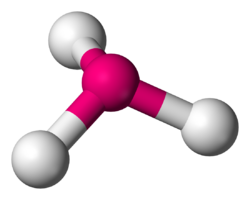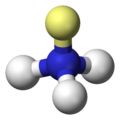Physics:Trigonal pyramidal molecular geometry
| Trigonal pyramidal molecular geometry | |
|---|---|
 | |
| Examples | NH3 |
| Point group | C3v |
| Coordination number | 3 |
| Bond angle(s) | 90°<θ<109.5° |
| μ (Polarity) | >0 |
In chemistry, a trigonal pyramid is a molecular geometry with one atom at the apex and three atoms at the corners of a trigonal base, resembling a tetrahedron (not to be confused with the tetrahedral geometry). When all three atoms at the corners are identical, the molecule belongs to point group C3v. Some molecules and ions with trigonal pyramidal geometry are the pnictogen hydrides (XH3), xenon trioxide (XeO3), the chlorate ion, ClO−3, and the sulfite ion, SO2−3. In organic chemistry, molecules which have a trigonal pyramidal geometry are sometimes described as sp3 hybridized. The AXE method for VSEPR theory states that the classification is AX3E1.

Trigonal pyramidal geometry in ammonia
The nitrogen in ammonia has 5 valence electrons and bonds with three hydrogen atoms to complete the octet. This would result in the geometry of a regular tetrahedron with each bond angle equal to cos−1(−1/3) ≈ 109.5°. However, the three hydrogen atoms are repelled by the electron lone pair in a way that the geometry is distorted to a trigonal pyramid (regular 3-sided pyramid) with bond angles of 107°. In contrast, boron trifluoride is flat, adopting a trigonal planar geometry because the boron does not have a lone pair of electrons. In ammonia the trigonal pyramid undergoes rapid nitrogen inversion.[1]
The electron pair arrangement of ammonia is tetrahedral: the two lone electrons are shown in yellow, the hydrogen atoms in white
See also
References
- ↑ Cleeton, C. E.; Williams, N. H. (1934). "Electromagnetic Waves of 1.1 cm Wave-Length and the Absorption Spectrum of Ammonia". Phys. Rev. 45 (4): 234. doi:10.1103/PhysRev.45.234. Bibcode: 1934PhRv...45..234C.
External links
- Chem| Chemistry, Structures, and 3D Molecules[yes|permanent dead link|dead link}}]
- Indiana University Molecular Structure Center
- Interactive molecular examples for point groups
- Molecular Modeling
- Animated Trigonal Planar Visual
 |



